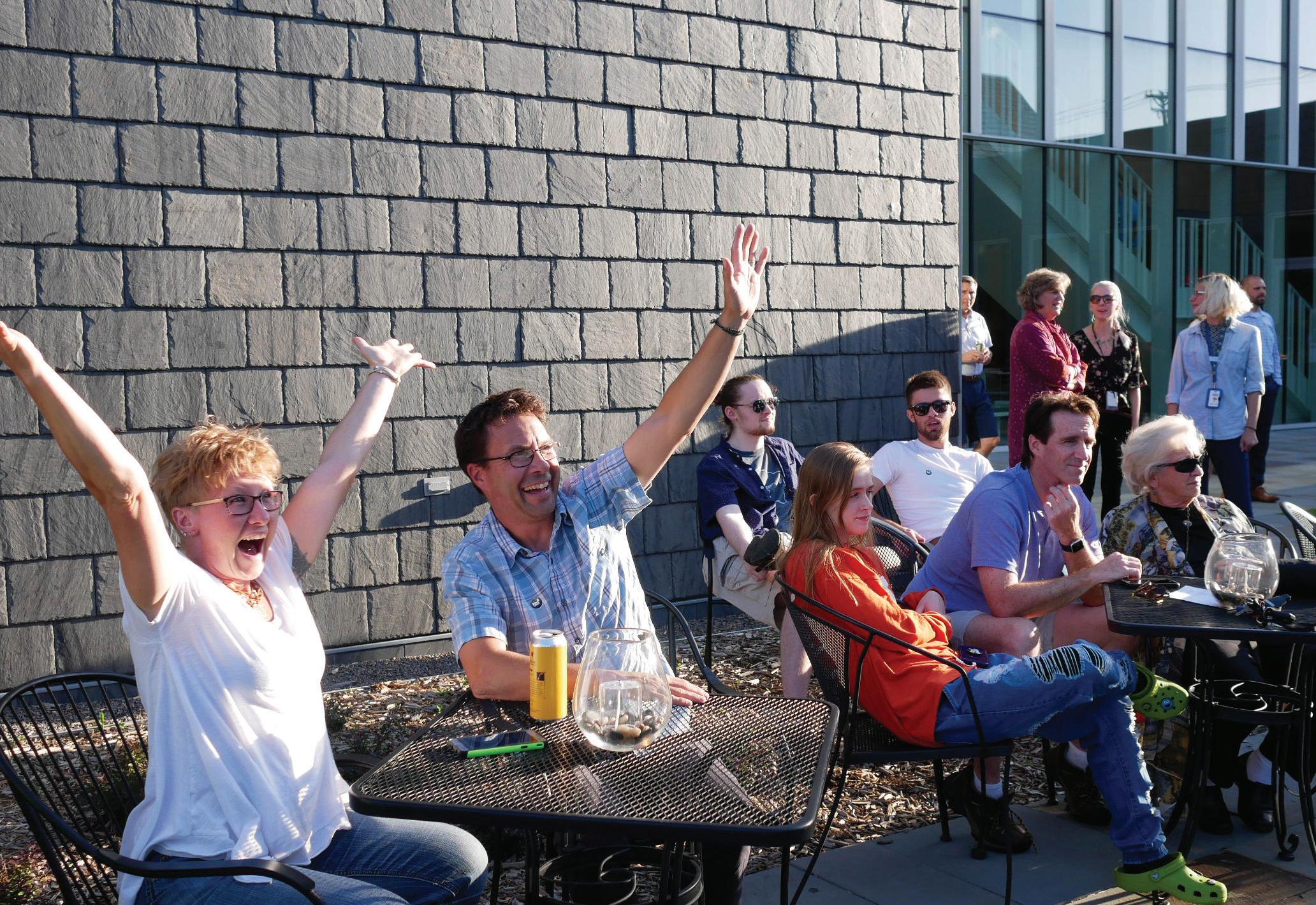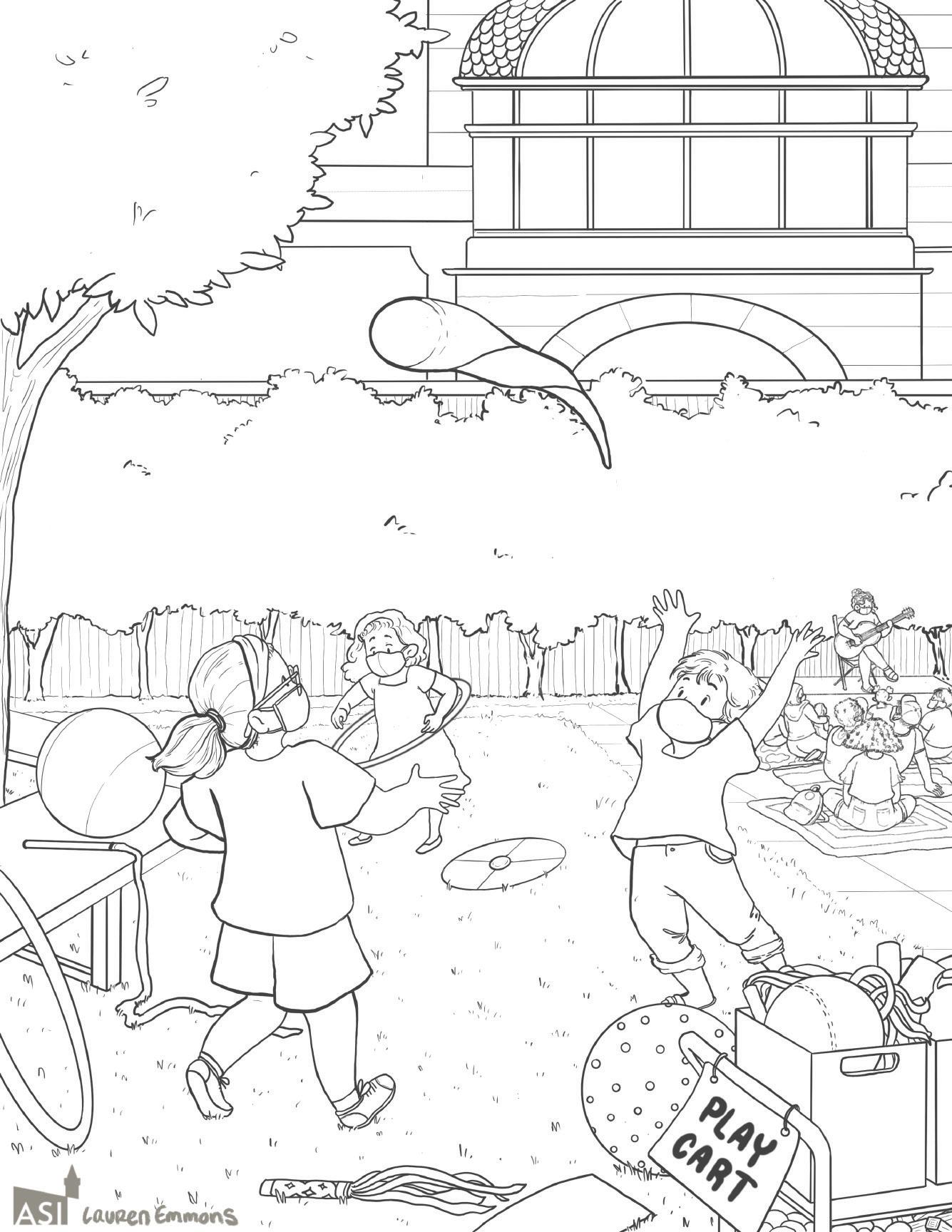
8 minute read
Exhibitions at ASI
The two exhibitions currently on display at ASI present three artists all using one common material — paper.
In the main exhibition from Sweden, Papier, Bea Szenfeld cuts, sews and sculpts paper fashions while Stina Wirsén puts ink to paper in her lively illustrations. The work of local artist Amy Sands sits somewhere in between. Based in Minneapolis, Amy Sands creates oneof-a-kind paper works that integrate traditional and digital methods of printmaking. Through the support of a Minnesota State Arts Board Artist Initiative Grant, Amy’s latest body of work utilizes ASI’s textile collection to inspire new patterns that are translated into paper cuts and then printed. Specifically, Amy has explored patterns and imagery from an old sample book of Swedish bobbin lace. The book belonged to Carolyn Hjelmerus, whose name can be seen on the cover of the book along with Knyppel Profver, or “Lace Tests”. Carolyn learned to make lace in Sweden and brought this book with her when she and her husband immigrated to Minnesota in 1889. Amy has long been exploring the concept of craft and women’s work in her art. Imagery sourced from textiles, lace and craft doilies emerge in her paper abstractions — paying homage to the history of women’s role in craft and the cultural value of the two. Amy’s work also pushes the boundaries of what has been historically defined as a print. Amy uses post-digital printmaking processes, such as laser cutters and digital engraving early in her process. This has expanded her thinking about paper and print; it is a balance of the conscious and the mechanical. Explore Amy’s work from small, delicate papercut prints on display in the Link (connecting the Nelson Culture Center to the Mansion) to life-size expression outdoors on ASI’s historic fence along Park Avenue. Amy Sands’s exhibition, Lace Reimagined, and the main exhibition, Papier, will be on view through July 11, 2021.
Advertisement
KINDERTRANSPORT COMING JULY 21
Kindertransport (German for "Children's Transport"), was the organized rescue effort that brought thousands of Jewish children from Nazi Europe to Great Britain and other countries in the late 1930s. This award-winning exhibition is being copresented by the Greenberg Family Fund for Holocaust Awareness at Beth El Synagogue, the Jewish Community Relations Council of Minnesota and the Dakotas (JCRC) and ASI.
“Craft is often illegitimately considered low-brow when compared to fine art — I aim to conflate these notions by bringing the patterns of craft into prints.” –Amy Sands
Thank You
“ASI provides a feast for our senses and expands our knowledge in unimagined ways.” -Karen Bieschke, ASI Member
One year since the American Swedish Institute first closed to the public in response to the pandemic, we want to say thank you. Last year following our closure, we gratefully received more than twice as many contributions from members and donors around the world as in years past. Many of you made these contributions in honor or memory of someone or something special in your life, and inspired us all with how you chose to reflect on gratitude during such a challenging time. This critical increase in support helped ASI through a year marked by multiple campus closures and limitations on the in-person gatherings that have been core to our mission. Your support empowered ASI to invest in new ways for us all to stay connected and empowered us to launch new online food, craft and language classes that now allow us all to learn about Scandinavian culture and heritage from wherever we are. For many people around the world, these programs have been a chance to connect with ASI for the first time. ASI Community Fund With community support, we also launched a Community Fund to assist our Phillips West neighborhood in recovering from unrest and impacts of the pandemic. We developed this fund to deepen our commitment to our neighbors in Phillips West who have supported us through the decades.

New Website Coming With support from one of our main foundation partners, you’ll soon see our website ASImn.org undergo an update to be a more effective resource for our global community and serve the needs of our audiences. New look for Posten You’ll also notice that this edition of Posten has a new look and feel. As part of our work to anchor ASI amid the unknowns of the pandemic, we looked to reaffirm our ongoing ties to Sweden and more deeply live out some of our values that are grounded in Scandinavian culture and heritage. These values — lagom, leende, ordning och reda and gemytlig — were beacons that guided our reimaging of Posten, and embody the experience we aim to offer all ASI participants, both in-person and online. Thank You — Your Gifts Have Impact Your support inspired us all in these challenging times, and your support is still needed. The challenges of last year still exist today and the pandemic continues to impact our organization. Each year, individual donations make up more than 50% of ASI’s annual budget and make it possible for us to pursue our mission as a gathering place for all people, offer educational programs and enlightening exhibitions for all, and preserve the Turnblad Mansion for future generations. Because of you, these new initiatives were possible. Because of you, ASI’s impact deepened despite the pandemic. Please consider a contribution to ASI to ensure we remain a resource for individuals around the world, for generations to come. Visit ASImn.org to make a contribution today. Thank you.
VIRTUAL PROGRAMMING
Since last March, more than 2000 community members have connected with ASI via virtual language, food, and craft classes, thanks to community support.
LAGOM LEENDE ORDNING OCH REDA GEMYTLIG
Not too little. Not too much. Just the right amount. Smiling Tidyness and order — Everything has its proper place.
A state or feeling of warmth and friendliness, and a sense of belonging and wellbeing springing from social acceptance.
Youth & Family Programs

Youth & Family Programs

Faces of ASI: Ingela Eilert Haaland
Outside Teaching

Ingela Eilert Haaland, a native Swede, is an inspiring educator who has taught language and cultural programs to adults and children at the American Swedish Institute since 2011. She is also an active musician who leads Lilla Spelmanslag and possesses a Swede’s avid appreciation of the outdoors, which she often incorporates into her teaching. Q. Tell us a little about your teaching background and how you got started at ASI I always wanted to be a teacher. I realized early on that teaching allows a person to hold on to a bit of everything: interpersonal relations, the joy of discovery in learning, being with children/ adults in a classroom setting, combining music, history, culture, stories, etymology, geography, and always, oneself, being a student with the students. It's a conductor's position, a constant dance of making space for everyone in the group so they can move forward and feel successful. I started as an elementary teacher in the Twin Cities. In 2011, I stepped into ASI as a substitute language teacher and I am delighted to still be here. Teaching adults was a new experience. I remember how the palms of my hands became clammy when we discussed grammar; I worried that my explanations would not be adequate.
One day, we all laughed about something, and at that moment a light went off in my head. Laughter is key to learning. It breaks down barriers and softens the obstacles of language acquisition. And today I love tackling grammar! Q. How did you end up in Minnesota from Sweden? Mine is the story of "came for a year, stayed for a lifetime." In 1994, I arrived at St. Olaf College with one small suitcase. After taking an English Literature class I was smitten — by words, texts, analyses, discussions. I completed a B.A. and returned to Minnesota after graduation to attend the University of Minnesota’s M.Ed. program. Then a dashing young man came riding by on a white horse (well actually, an old tan Honda), and the rest, as they say, is history. Q. Sweden is known for its respect for the environment, can you give us the highlights? Scandinavians are very connected to the outdoors. During COVID, Swedes moved many gatherings outside and emphasize staying two meters apart. A Swedish law, Allemansrätten, also states that Swedes have the right to enjoy nature, regardless of who owns the land. We may walk through forests and meadows and collect berries and mushrooms. Land owners must provide a gate or stätta so people can pass. Förskolor, or child care centers, also have outdoor shelters where children take naps. Q. Many of your classes include aspects of nature, how is that effective? During one hiking club event, we stopped to read poetry aloud in Swedish (and have fika). One student was very familiar with trees along the Mississippi and prepared (in Swedish) a beautiful, detailed explanation. Knowing about the flora and fauna and breathing in the seasons connects you with the here and now. Seeing, touching, listening to and learning about nature incorporates numerous senses, which deepens language acquisition. Birding and mushroom hunting are other delightful themes. I’m also excited that Svenska skolan will continue to be held outside this spring! Last fall, we had a joyous time, because we simply moved our classroom outside into ASI’s green spaces. We enjoyed a tomte-centered nature theme. Q. You also lead the youth fiddler group, ASI's Lilla Spelmanslag, how have you incorporated the outdoors into that? Lilla Spelmanslaget rehearsed in my back yard last fall and played wearing masks. Neighbors came to listen, and cars drove by, slowly, to soak in the music. We even had an outdoor virtual workshop with Anders and Maria Larsson from Sweden and performed outside at two senior living residences. This helped balance out the grand disappointment postponing a summer trip to Dalarna, Småland and Skåne after receiving a grant to play at a youth fiddle camp.
SWEDISH HIKING CLUB
Open to all levels of Swedish speakers. Please note that we will try to stick to Swedish as much as possible. Conversation topics and activities will be prepared in advance. June 26, July 10 and August 14. Visit ASImn.org for more information.








